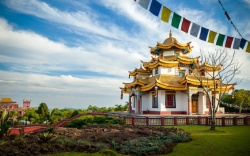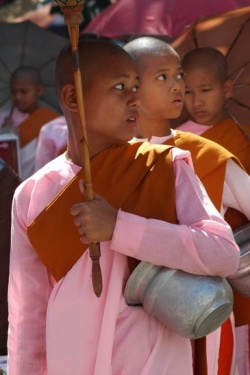Difference between revisions of "The Great Ngok Translator"
(Created page with " The Great Ngok Translator In the year 1159, one of Dorje Shugden’s previous incarnations took rebirth by the shores of Lake Yardrok in Lhoka, [...") |
|||
| (One intermediate revision by the same user not shown) | |||
| Line 1: | Line 1: | ||
| − | + | <nomobile>{{DisplayImages|4316|3030|2852}}</nomobile> | |
| − | |||
| − | |||
| − | + | ||
| + | The [[Great Ngok Translator]] | ||
| + | |||
| + | In the year 1159, one of [[Dorje Shugden’s]] previous [[incarnations]] took [[rebirth]] by the shores of [[Lake Yardrok]] in [[Lhoka]], [[Tibet]]. Born within the illustrious [[Ngok family]], his father was Chokyab and his mother was known as Pelmo. | ||
| + | |||
| + | His uncle, [[Ngok Lotsawa]] [[Lekpai Sherab]] was one of the three main [[disciples]] of [[Jowo Dipamkara]] [[Atisha]] and it was this uncle who [[taught]] [[Loden Sherab]] single-handedly throughout the earlier part of his [[life]]. His uncle also founded [[Sangpu Neutog Monastery]] in 1073, one of the greatest seats of [[Buddhist]] {{Wiki|learning}} in [[Tibet]] at that time, and this would also become [[Loden Sherab’s]] seat in his later years. | ||
| + | |||
| + | Three years later, [[Lotsawa Lekpai Sherab]] [[ordained]] the young man and gave him the [[name]] [[Loden Sherab]]. That very same year, [[Loden Sherab]] attended the most important [[gathering]] of [[Buddhist masters]] of the {{Wiki|era}}, the [[Fire]] [[Dragon]] [[Religious]] Conference, that was sponsored by [[King]] Tsede, the nephew of [[King]] [[Jangchub Ö]] of the old [[Guge]] {{Wiki|Kingdom}}. Great [[masters]] and [[translators]] from all over [[Tibet]], [[India]] and [[Kashmir]] attended the conference with the {{Wiki|purpose}} of facilitating better translations of the great [[Buddhist]] treatises. As one of the methods of fulfilling this [[objective]], the young [[Loden Sherab]] was selected to travel to [[India]] in order to study [[Sanskrit]]. | ||
[[Loden Sherab]] was believed to have secured an amount from the {{Wiki|royal}} treasury for such an endeavor and travelled first to [[Kashmir]] with five other travelling companions, all of whom would later become well-known [[translators]] and amongst them, [[Ra Lotsawa Dorje Drak]] would eventually become the most famous. | [[Loden Sherab]] was believed to have secured an amount from the {{Wiki|royal}} treasury for such an endeavor and travelled first to [[Kashmir]] with five other travelling companions, all of whom would later become well-known [[translators]] and amongst them, [[Ra Lotsawa Dorje Drak]] would eventually become the most famous. | ||
| Line 11: | Line 16: | ||
While in [[Kashmir]], the travelling companions spent most of their time in [[Anupama]], a beautiful [[ancient]] city that is known today as [[Srinagar]]. They worked with several learned [[panditas]] there including the one known as [[Bhavyaraja]], whom they worked with mostly on the translation of [[logic]] treatises. At that time, such treatises were part of the study and [[interest]] of all [[religions]] in [[Tibet]] and it was common for [[logicians]] from various [[religious]] [[traditions]] to engage in [[debates]]. After that, [[Loden Sherab]] went on [[pilgrimage]] to the [[Buddha’s]] [[seat of enlightenment]] at [[Bodhgaya]] despite the huge distance. | While in [[Kashmir]], the travelling companions spent most of their time in [[Anupama]], a beautiful [[ancient]] city that is known today as [[Srinagar]]. They worked with several learned [[panditas]] there including the one known as [[Bhavyaraja]], whom they worked with mostly on the translation of [[logic]] treatises. At that time, such treatises were part of the study and [[interest]] of all [[religions]] in [[Tibet]] and it was common for [[logicians]] from various [[religious]] [[traditions]] to engage in [[debates]]. After that, [[Loden Sherab]] went on [[pilgrimage]] to the [[Buddha’s]] [[seat of enlightenment]] at [[Bodhgaya]] despite the huge distance. | ||
| − | Upon his return to [[Tibet]], [[Loden Sherab]] invited many [[panditas]] to the [[Land of Snows]] to assist in the translation of the [[Sanskrit]] treatises. It was said that in the course of his [[life]], [[Loden Sherab]] translated over 137,000 verses and trained countless students in [[Buddhist philosophy]], [[logic]], and [[tantric practices]]. Such was his [[popularity]] that | + | Upon his return to [[Tibet]], [[Loden Sherab]] invited many [[panditas]] to the [[Land of Snows]] to assist in the translation of the [[Sanskrit]] treatises. It was said that in the course of his [[life]], [[Loden Sherab]] translated over 137,000 verses and trained countless students in [[Buddhist philosophy]], [[logic]], and [[tantric practices]]. Such was his [[popularity]] that every time he gave a [[teaching]], over 20,000 students would attend and he needed up to 2,000 assistant [[teachers]] to help him. Along with his translation works, he is credited with bringing the [[lineage]] of the [[Dharma Protector Setrab Chen]] from [[India]] to [[Tibet]]. |
| − | Just before his passing, [[Loden Sherab]] told his closest [[disciples]], Zhang Tshepongwa Chokyi [[Lama]] and Drolungpa Jungne, to remember the [[impermanence]] of the [[body]] and urged them to continue studying the [[Three Baskets]] of the [[Buddha’s teachings]], the [[Tripitaka]]. In [[essence]], he was forewarning them of his impending demise. | + | Just before his passing, [[Loden Sherab]] told his closest [[disciples]], [[Zhang Tshepongwa Chokyi]] [[Lama]] and [[Drolungpa Jungne]], to remember the [[impermanence]] of the [[body]] and urged them to continue studying the [[Three Baskets]] of the [[Buddha’s teachings]], the [[Tripitaka]]. In [[essence]], he was forewarning them of his impending demise. |
| − | While at Mari, in the same area as [[Samye Monastery]], [[Loden Sherab]] entered [[clear light]]. Soon after, there were reports of [[earth]] tremors and the sky was filled with [[rainbows]], [[celestial]] lights and [[mystical]] {{Wiki|sounds}} of [[dakinis]] singing. His remains were [[Wikipedia:cremation|cremated]] in the same valley where [[Sangphu | + | While at Mari, in the same area as [[Samye Monastery]], [[Loden Sherab]] entered [[clear light]]. Soon after, there were reports of [[earth]] tremors and the sky was filled with [[rainbows]], [[celestial]] lights and [[mystical]] {{Wiki|sounds}} of [[dakinis]] singing. His remains were [[Wikipedia:cremation|cremated]] in the same valley where [[Sangphu Monastery]] was located. The [[relics]] that emerged from his [[body]] were also enshrined within a [[stupa]] at the same location. |
{{R}} | {{R}} | ||
[http://www.dorjeshugden.com/introduction/incarnation-lineage/lotsawa-loden-sherab/] | [http://www.dorjeshugden.com/introduction/incarnation-lineage/lotsawa-loden-sherab/] | ||
[[Category:Tibetan Translators]] | [[Category:Tibetan Translators]] | ||
Latest revision as of 09:33, 21 October 2015
In the year 1159, one of Dorje Shugden’s previous incarnations took rebirth by the shores of Lake Yardrok in Lhoka, Tibet. Born within the illustrious Ngok family, his father was Chokyab and his mother was known as Pelmo.
His uncle, Ngok Lotsawa Lekpai Sherab was one of the three main disciples of Jowo Dipamkara Atisha and it was this uncle who taught Loden Sherab single-handedly throughout the earlier part of his life. His uncle also founded Sangpu Neutog Monastery in 1073, one of the greatest seats of Buddhist learning in Tibet at that time, and this would also become Loden Sherab’s seat in his later years.
Three years later, Lotsawa Lekpai Sherab ordained the young man and gave him the name Loden Sherab. That very same year, Loden Sherab attended the most important gathering of Buddhist masters of the era, the Fire Dragon Religious Conference, that was sponsored by King Tsede, the nephew of King Jangchub Ö of the old Guge Kingdom. Great masters and translators from all over Tibet, India and Kashmir attended the conference with the purpose of facilitating better translations of the great Buddhist treatises. As one of the methods of fulfilling this objective, the young Loden Sherab was selected to travel to India in order to study Sanskrit.
Loden Sherab was believed to have secured an amount from the royal treasury for such an endeavor and travelled first to Kashmir with five other travelling companions, all of whom would later become well-known translators and amongst them, Ra Lotsawa Dorje Drak would eventually become the most famous.
While in Kashmir, the travelling companions spent most of their time in Anupama, a beautiful ancient city that is known today as Srinagar. They worked with several learned panditas there including the one known as Bhavyaraja, whom they worked with mostly on the translation of logic treatises. At that time, such treatises were part of the study and interest of all religions in Tibet and it was common for logicians from various religious traditions to engage in debates. After that, Loden Sherab went on pilgrimage to the Buddha’s seat of enlightenment at Bodhgaya despite the huge distance.
Upon his return to Tibet, Loden Sherab invited many panditas to the Land of Snows to assist in the translation of the Sanskrit treatises. It was said that in the course of his life, Loden Sherab translated over 137,000 verses and trained countless students in Buddhist philosophy, logic, and tantric practices. Such was his popularity that every time he gave a teaching, over 20,000 students would attend and he needed up to 2,000 assistant teachers to help him. Along with his translation works, he is credited with bringing the lineage of the Dharma Protector Setrab Chen from India to Tibet.
Just before his passing, Loden Sherab told his closest disciples, Zhang Tshepongwa Chokyi Lama and Drolungpa Jungne, to remember the impermanence of the body and urged them to continue studying the Three Baskets of the Buddha’s teachings, the Tripitaka. In essence, he was forewarning them of his impending demise.
While at Mari, in the same area as Samye Monastery, Loden Sherab entered clear light. Soon after, there were reports of earth tremors and the sky was filled with rainbows, celestial lights and mystical sounds of dakinis singing. His remains were cremated in the same valley where Sangphu Monastery was located. The relics that emerged from his body were also enshrined within a stupa at the same location.


